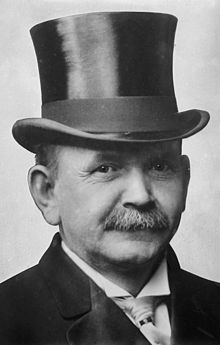Top hat

- For the movie starring Fred Astaire see Top Hat
A top hat or top-hat (sometimes also known by the nickname "topper") is a kind of tall, flat-crowned, broad-brimmed hat worn by men throughout the 1800s and early 1900s but which are now usually only worn with morning dress or evening dress. The first top hat was made by John Hetherington in 1797, however, the hats only became popular in the 1820s. Top hats were very common as they were worn by men for business, social events, and pleasure.
They were made from stiffened felt made from beaver fur and later, due to the influence of Prince Albert, from silk. A popular version, particularly in the United States in the 19th century, was the stovepipe hat, which was popularized by Abraham Lincoln during his presidency. Unlike many top-hats, this version was straight, like piping, and was not wider at the top and bottom. Often they were taller than the typical top-hat.
Later on, top-hats were sometimes given an internal hinged frame, making them collapsible. Such hats are often called "opera hats" or "Gibus(ses)," though the term can be synonymous with any top-hat, or any tall formal men's hat. In the 1920's they were also often called "high hats".
In the latter half of the 19th century, the top hat gradually fell out of fashion, with the middle classes adopting bowler hats and soft felt hats such as fedoras, which were more convenient for city life, as well as being suitable for mass production. In comparison, a top hat needed to be handmade by a skilled hatter, with few young people willing to take up what was obviously a dying trade. The top hat became associated with the upper class, becoming a target for satirists and social critics. By the end of World War I it had become a rarity in everyday life. It continued to be used for formal wear, with a morning suit in the daytime and with evening clothes (tuxedo or tailcoat) until the late 1930's.
The top hat persisted in certain areas, such as politics and international diplomacy, for several more years. In the newly-formed Soviet Union, there was a fierce debate as to whether its diplomats should follow the international conventions and wear a top hat, with the pro-toppers winning the vote by a large majority.
Top-hats are sometimes associated with stage magic. They also appear as a form of party hat.
President John F. Kennedy was the only President of the United States to wear a stovepipe hat to a presidential inauguration. The last president to wear a top hat to an inauguration was Richard Nixon. Gerald Ford was not inaugurated at the Capitol and Jimmy Carter abolished the use of morning dress for inaugurations. It was reinstated, minus a top hat, by Ronald Reagan but not worn by any later presidents to date.
Nowadays cheap imitations of top hats are made for white tie, as well as events calling for morning dress. They are usually made in the stovepipe style and with a flat brim as making it correctly would be too expensive.
Notable wearers
- Uncle Sam, a national personification of the United States.
- John Bull, a national personification of England and sometimes Britain.
- Abraham Lincoln, sixteenth president of the United States.
- Isambard Kingdom Brunel, a notable 19th Century British engineer.
- Slash, lead guitarist in Guns and Roses and Velvet Revolver.
- Duke Ellington, influential American Jazz musician.
- Professor Hinkle, magician in the TV special Frosty the Snowman, whose discarded top hat ends up bringing Frosty to life.
- Fred Astaire, American film star.
- Jerry Sadowitz, provocative comedian and magician.
- Coffin Joe, Brazilian horror film character.
- Baron Samedi, an aspect of the Baron loa in voodoo.
- Screaming Lord Sutch, founder of the Official Monster Raving Loony Party, a spoof UK political party.
- Hans Christian Andersen, Danish author and poet famous for his fairy tales.
- Rich Uncle Pennybags, the mascot for the game monopoly.
- Scrooge McDuck, wealthy Disney character.
- Raymond Griffith, silent film comedian.
- Willy Wonka, fictional chocolate factory owner created by Roald Dahl.
- Dr. Demento, Los Angeles radio personality.
- The Penguin, one of Batman's enemies.
- The Mad Hatter, a fictional character that appears in Lewis Carroll's Alice's Adventures in Wonderland.
- Papa Lazarou, demonic circus owner from BBC comedy series The League of Gentlemen.
- Stevie Nicks, iconic singer/songwriter, both a solo artist and a member of Fleetwood Mac
- Brendon Urie, lead singer of the band Panic! At the Disco
- Boy George, lead singer of Culture Club in the 80's
Further reading
- Neil Steinberg, Hatless Jack - The President, the Fedora and the Death of the Hat, 2005, Granta Books
